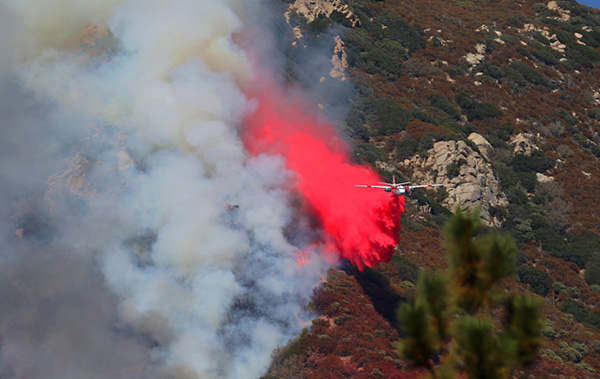Forest fires are becoming more problematic across the globe. For example, climate change has extended fire season in the United States by about 80 days since 1970 because of extreme weather events, such as prolonged drought, according to the U.S. Forest Service. In more fire-prone regions, such as the western United States, fire season now lasts almost year-round. While it cannot extinguish fires, fire retardant is an important tool for slowing the spread of forest fires. Such retardants typically incorporate ammonium phosphate [active ingredient (NH4)2HPO4], a thickener that helps adhere the retardant to vegetation, a red colorant for visual tracking, and water. Upon heating, the retardant’s ammonium phosphate decomposes to ammonia (NH3) and phosphoric acid (H3PO4). Phosphoric acid then reacts with cellulose on the surface of burning plants to produce a carbon layer (char) that shields the underlying organic material from heat and oxygen to prevent further combustion. See also: Ammonia; Combustion; Drought; Extreme weather events; Fire; Flame; Flameproofing; Forest fire; Global climate change; Phosphorus

The source of ammonium phosphate used in fire retardants is phosphate minerals, which are naturally occurring inorganic salts of phosphoric acid. Phosphate minerals are non-renewable resources, and the mining of phosphate minerals often results in significant environmental damage and pollution. In searching for a more sustainable source of phosphate minerals, researchers reporting in the journal Green Chemistry (June 2021) found that magnesium ammonium phosphate, or struvite (NH4MgPO4)— a phosphate mineral derived from wastewater—was as effective as ammonium phosphate in fire retardant formulations. Struvite forms in water treatment plants when magnesium (from salts in water, particularly hard water), ammonia (a byproduct of urea and urine), and phosphate (from organic matter) combine to form crystals. Additional research showed that wastewater treatment plants produce enough struvite to meet fire-retardant needs for U.S. wildfires. See also: Magnesium; Mining; Phosphate mineral; Urea; Urine; Water treatment
Because struvite previously has been used as a slow-release fertilizer without significant impacts, these crystals are not considered to be an environmental hazard when used to combat wildfires. Experts also consider the use of struvite in fire retardants to be more environmentally friendly than the mining of phosphate minerals to produce ammonium phosphate. Perimeter Solutions, the company that supplies the U.S. Forest Service with fire retardants, acquired the rights and technology for producing struvite-based fire retardants in 2020 and has already begun manufacturing these products. See also: Environmental management; Fertilizer





